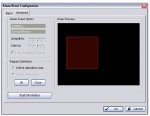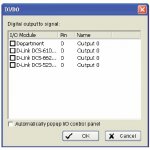Television and analogue video signals are something I am reasonably familiar with, if I let you have a little background information, it may help you see what my idea was and whether it will be suitable for your application.
A television picture is made up of a number of lines, each line is scanned starting with line one at the top left corner of the screen, line one being completed at the top right of the screen. Line three starts not quite directly under line one, again at the (nearly top) left and finishes on the right. Each successive (odd numbered) line is positioned underneath the previous one until the bottom right corner of the screen is reached. To do this requires some timing 'markers' so that the viewing screen is synchronised with the transmitting screen to ensure that the picture is correctly displayed. With no timing the picture would be nothing but a jumbled mess.
In the UK the picture is made up of 625 lines, this is broadcast in two fields of 312.5 lines, two fields making one frame. The 312.5 lines of one field are positioned with a slight [one horizontal line] vertical offset so that they are interleaved with one another, they do not overwrite the other field [interlaced]. The fields are transmitted in what is considered to be odd and even numbered fields, the odd field having line numbers 1, 3, 5, 7... then the even field with lines 2, 4, 6, 8...
A line is transmitted every 64uS, a field every 20mS, and a complete frame every 40mS.
The LM1881 takes a composite video signal and decodes it into the timing signals, the field sync pulse indicating the start of the field (600uS wide), the line sync pulse indicating the start of the line (5uS wide) and the frame sync indicator denoting whether the next field is odd or even (a modified field sync pulse).
If you wanted to look at an object that was in the dead centre of the screen, you would need to start a counter at the end of the field sync pulse, count 156 (half of 312.5) line sync pulses, pause for 32uS (half of the 64uS line length) and then start looking. For near to the top left corner, count 5 line sync pulses, pause for 10uS then start looking. For something that was nearly in the bottom corner, you'd have to count 300 line sync pulses, pause for 50uS and then start looking. Unless your object was one pixel wide, by one pixel high, this wouldn't be terribly practical, but hopefully it gives you somewhere to start your thinking from. Due to various 'housekeeping' features provided by the broadcast signal, these timings are not going to be absolutely accurate, but they should be close enough to get you on your way.
I have only considered analogue signals here, but I would be surprised if your video cameras do not have analogue outputs. If they are IP cameras, or network connected cameras they could be fully digital, if that is the case this theory (and the LM1881) will be wasted. The interlacing is not likely to require consideration either, unless you really are trying to track something that would only be visible on one single line, and not on any other. Also this does not consider colour, unless you really need to track very specific colours I'd ignore it. If you do need to track specific colours you'd need to do some decoding of the PAL colour signal first, that would give you the red, green and blue colour signals from which you would need to determine how to combine and filter these colours to eliminate unwanted colours yet leave the wanted ones. Not for the faint of heart!
The line selector circuit that TI showed in the datasheet for the LM1881 would allow either one line, or a number of lines to be passed through for further processing, this would give a thin horizontal 'slit' of complete lines, if you were interested in something that was to the right hand side of this 'slit' you would have to still wait for up to 50uS after the line sync pulse before asking the PicAxe to look for the changes you require.
The Wikipedia page on PAL has some oscillograms of video signals which neatly illustrate the picture information as it is transmitted.
http://en.wikipedia.org/wiki/PAL
There is an article on the NI website which again shows some of the theory of a video signal.
http://www.ni.com/white-paper/4750/en/
Good luck!


